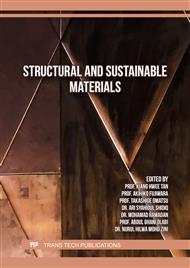[1]
B. Aurivillius, "Mixed bismuth oxides with layer lattices i. structure of CaBi2B2O9," Ark. Kemi, vol. 1, p.463--480, 1949.
Google Scholar
[2]
E. J. Nichols, "Aurivillius Phase Oxides for Photocatalytic Applications," P.hD. dissertation, Alfred University, 2010.
Google Scholar
[3]
H. Djani, "Modélisation ab initio des oxydes ferroélectriques à phase aurivillius," P.hD. dissertation, Université des sciences et de la technologie Houari Boumediene, 2012.
DOI: 10.20537/nd220101
Google Scholar
[4]
J. D. Bobić, M. M. Vijatović-Petrović, and B. D. Stojanović, "Aurivillius BaBi4Ti4O15 based compounds: Structure, synthesis and properties," Processing and Application of Ceramics, vol. 7, no. 3, p.97--110, 2013.
DOI: 10.2298/pac1303097b
Google Scholar
[5]
C. M. Bedoya Hincapie, M. J. Pinzon Cardenas, A. Orjuela, J. Edgar, E. Restrepo Parra, and J. J. Olaya Florez, "Physical-chemical properties of bismuth and bismuth oxides: Synthesis, characterization and applications," Dyna, vol. 79, no. 176, p.139--148, 2012..
Google Scholar
[6]
V. Dorcet, "Etude de la relation entre structure et propriétés des pérovskites pseudo-cubiques du système Na0,5Bi0,5TiO3 – BiFeO3," P.hD. dissertation, Université de Limoges, 2008.
Google Scholar
[7]
K. R. Kendall, C. Navas, J. K. Thomas, and H.-C. zur Loye, "Recent developments in oxide ion conductors: Aurivillius phases," Chemistry of materials, vol. 8, no. 3, p.642--649, 1996.
DOI: 10.1021/cm9503083
Google Scholar
[8]
J. Valasek, "Piezo-electric activity of rochelle salt under various conditions," Physical Review, vol. 19, no. 5, p.478, 1922.
DOI: 10.1103/physrev.19.478
Google Scholar
[9]
E. Subbarao, "A family of ferroelectric bismuth compounds," Journal of Physics and Chemistry of Solids, vol. 23, no. 6, p.665--676, 1962.
DOI: 10.1016/0022-3697(62)90526-7
Google Scholar
[10]
G. Smolenskii, "Ferroelectrics of the oxygen-octahedral type with layered structure," Sov. Phys. Solid State, vol. 3, no. 3, p.651, 1961.
Google Scholar
[11]
V. Isupov, "Systematization of aurivillius-type layered oxides," Inorganic materials, vol. 42, no. 10, p.1094--1098, 2006.
DOI: 10.1134/s0020168506100086
Google Scholar
[12]
A. Peláiz-Barranco and Y. González-Abreu, "Ferroelectric ceramic materials of the aurivillius family," Journal of Advanced Dielectrics, vol. 3, no. 04, p.1330003, 2013.
DOI: 10.1142/s2010135x1330003x
Google Scholar
[13]
Y. Wang, E. Delahaye, C. Leuvrey, F. Leroux, P. Rabu, and G. Rogez, "Post-synthesis modification of the aurivillius phase Bi2SrTa2O9 via in situ microwave-assisted "click reaction," Inorganic chemistry, vol. 55, no. 19, p.9790--9797, 2016.
DOI: 10.1021/acs.inorgchem.6b01600
Google Scholar
[14]
M. Tomar, "Structural and ferroelectric properties of aurivillius phase materials," Integrated Ferroelectrics, vol. 42, no. 1, p.191--205, 2002.
DOI: 10.1080/10584580210847
Google Scholar
[15]
E. Fortalnova, M. Safronenko, I. Smagin, E. Politova, M. Kurasova, and A. Mosunov, "Synthesis and investigation of re (iii) cation substituted SBN and SBT ceramics," Ferroelectrics, vol. 511, no. 1, p.62--68, 2017.
DOI: 10.1080/00150193.2017.1333897
Google Scholar
[16]
V. Yanovskii and V. Voronkova, "Structure, polymorphism, and ferroelectric properties of mixed layered bismuth-containing compounds," Inorg. Mater.(Engl. Transl.);(United States), vol. 22, no. 12, 1987.
Google Scholar
[17]
I. Bella, T. P. Wendari, N. Jamarun, and N. Mufti, "Structural transformation in Mn-substituted Sr2Bi2Ta2TiO12 Aurivillius phase synthesized by hydrothermal method: A comparative study and dielectric properties", Ceramics International, vol. 47, no. 6, 8014-8019, 2021.
DOI: 10.1016/j.ceramint.2020.11.154
Google Scholar
[18]
A. Rosyidah, D. Onggo, K. Khairurrijal, and I. Ismunandar, "Ferroelectric properties of BaBi4Ti4O15 doped with Pb2+, Al3+, Ga3+, In3+, Ta5+ aurivillius phases," Indonesian Journal of Chemistry, vol. 9, no. 3, p.398--403, 2010.
Google Scholar
[19]
M. Mączka, L. Macalik, and S. Kojima, "Temperature-dependent raman scattering study of cation-deficient aurivillius phases: Bi2WO6 and Bi2W2O9," Journal of Physics: Condensed Matter, vol. 23, no. 40, p.405902, 2011.
DOI: 10.1088/0953-8984/23/40/405902
Google Scholar
[20]
B. Wang, and A. Navrotsky, "Thermodynamics of cesium lead halide (CsPbX3, x= I, Br, Cl) perovskites", Thermochimica Acta, vol. 695, p.178813, 2021.
DOI: 10.1016/j.tca.2020.178813
Google Scholar
[21]
K. Meng, W. Li, Y. Zhang, S. Zhang, X. Tang, X. Guo, and Y. Jiang, "The thermal conductivity and tolerance factor modulated ferroelectric thermal stability of Ba0.955La0.03TiO3 relaxor ferroelectric", Journal of Materials Science: Materials in Electronics, vol. 33, no. 10, 7621-7635, 2022.
DOI: 10.1007/s10854-022-07911-9
Google Scholar
[22]
M. W. Lufaso, "Perovskite synthesis and analysis using structure prediction diagnostic software," P.hD. dissertation, The Ohio State University, 2002.
Google Scholar



